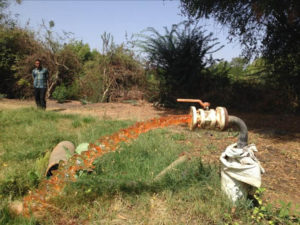The Central Pollution Control Board (CPCB), Government of India’s anti-pollution watchdog, has taken strong exception to the Vadodara Enviro Channel Ltd (VECL), responsible for disposal of treated waste water of hundreds of industrial units in and around Vadodara, for virtually discharging effluents into the estuarine zone of Mahi river, Gulf of Khambhat.
VECL is an industry-supported body in the “business” of conveyance of “treated” wastewater from industrial units in and around Vadodara district through the 55-km-long channel into the Bay of Khambhat, discharging it at the Mahi estuarine zone.

In a letter dated December 17 to the Gujarat Pollution Control Board (GPCB) chairman, the CPCB member-secretary states that CPCB monitoring results on September 10, 2019 has found very high pollution levels in wastewater being discharged allegedly after treating the effluents produced by industrial units.
Thus, says the CPCB official, “Concentration of total suspended solids (TSS), chemical oxygen demand (COD) and total dissolved solids (TDS) and biochemical oxygen demand (BOD) was exceeding 4.24, 3.51, 6.49 and 1.75 times respectively than the prescribed discharge standards.”
The monitoring at the Mahi river estuary, called J-Point, was carried out in response to public outcry by Paryavaran Suraksha Samiti (PSS), a Vadodara-based environmental NGO, admits the CPCB letter, adding, such high levels of pollution were found despite “drastic dilution of effluent in the conveyance system due to heavy rain.”
Pointing out that the situation with regard to the discharge of untreated waste water has not changed for years despite repeated warnings by GPCB, the CPCB member-secretary says, “It is inferred from the CPCB monitoring results during 2015-18 that VECL is consistently found non-complied at J-Point with regard to prescribed discharge standards and concentration of various parameters.”
Thus, during 2015-18 “COD is found exceeding 1.36 to 11.39 times, BOD 2.44 to 5.56 times, ammonia and nitrogen ammonia (NH3-N) 1.61 to 7.74 times, TSS 1.06 to 4.43 times, TDS 1.58 to 3.42 times than the prescribed discharge standards.”
According to CPCB, “VECL, in spite of repeated directions by GPCB, has continued to be non-compliant by diverting effluent into existing effluent channel citing operative issues of newly laid pipeline.”
Brushing aside the argument, CPCB says, “The newly commissioned pipeline has not been designed to handle excess hydraulic load on account of rain if any, i.e. factor of safety has not been considered while designing and commissioning of pipeline, resulting in divergence of effluent into the existing effluent channel.”
It continues, “It is evidence from present inspection that at certain stretches of effluent channel (especially after Vedach pumping station towards J-Point) the sidewall of effluent channel was breached due to excess hydraulic load on account of heavy rain, resulting in spreading of effluent into nearby agricultural fields and ponds.”
It adds, “The water samples collected from alleged locations found contaminated with overflow from effluent conveyance system and has not shown appreciable changes in the water quality even due to drastic dilution of effluent with rain water and prevailing water in the pond, percolation of contaminated water in the agricultural field.”
Asking GPCB to go strict with VECL, though refusing to recall the PSS insistence that industrial units discharging untreated wastewater should be closed down, CPCB says, GPCB should also conduct “detailed assessment of groundwater quality in the area for ascertaining groundwater contamination and take remedial measures.”
At the same time, it adds, GPCB should submit “time-bound action plan for remediation of the contaminated wells/any water body” within 30 days.
Courtesy: Counterview










